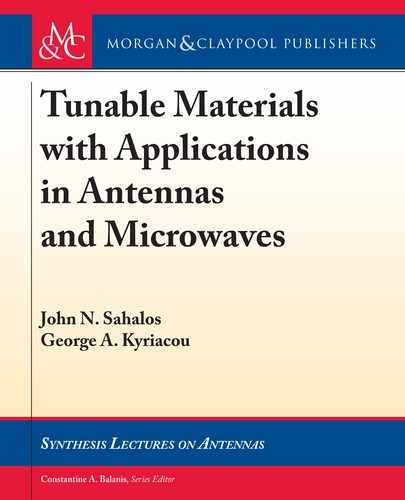
60 2. TUNABLE MATERIALS–CHARACTERISTICS AND CONSTITUTIVE PARAMETERS
Final
Inspection
Green Dielectric
Tape
Collating
Dimension
Meas. and
Electric T
esting
Co-Firing
Blanking Via Punching Via Filling Conductor Printing
Pre-Cutting Laminating
Figure 2.30: e LTCC technology.
absence of hysteresis losses. us, ferroelectrics like BSTO are mostly used in their paraelectric
state. e Curie temperature of BSTO can be controlled by the Ba/Sr content ratio (x) [59, 61].
us, BSTO (Ba
1–X
Sr
X
TiO
3
) is available in a lot of different forms, depending on the am-
bient temperature for its intended use. For the values of X D 0:3 and 0.45, the corresponding
Curie temperatures are T
C
D 310 K and 254 K, while the 0.4 Ba
0.55
Sr
0.45
TiO
3
0.6 MgO
has T
C
D 209 K. e MgO additive minimizes microwave losses but also causes a reduction in
permittivity [62].
2.21 THEORY OF THE FERROELECTRIC DIELECTRIC
RESPONSE
According to Tagantsev et al. [39] and the references therein, the dielectric response of ferro-
electrics was given by the Ginzburg–Landau theory. is is based on a series expansion of the
Helmholtz free energy F with respect to vector macroscopic polarization
N
P . When the material
is considered to be isotropic, in other words, when polarization is assumed to be collinear to the
macroscopic electric field, the vector notation can be dropped. Approximating free energy with
the first two terms of the expansion, we have:
F D
˛
2
P
2
C
ˇ
4
P
4
; (2.40)
where ˛ and ˇ are constants.
e derivative of free energy with respect to polarization is equal to the electric field
E D
@F
@P
D ˛P C ˇP
3
: (2.41)

2.21. THEORY OF THE FERROELECTRIC DIELECTRIC RESPONSE 61
e electric permittivity (") of the medium is equal to the derivative of polarization P
with respect to the electric field " D @P =@E; in other words, observing (2.41), for any value of
the electric field, permittivity is defined as the slope of the polarization curve.
" D "
0
"
r
D
@P
@E
D
1
˛ C 3ˇP
2
: (2.42)
Let ".0/ D 1=.˛"
0
/ or "
0
".0/ D 1=˛, where "
0
D 8:854 10
12
F/m is the permittivity
of free space. e dielectric constant can be written as:
"
r
D ".0/
1
1 C 3ˇ "
0
".0/ P
2
: (2.43)
From Eq. (2.43), it is obvious that ".0/ represents the relative permittivity in the absence of
a biasing electric field P D P
dc
D 0. According to the Ginzburg–Landau theory, the coefficient
˛ is regarded as a linear function of temperature and vanishes at the Curie–Weiss temperature
T
C
.
˛ D ˛
GL
D
1
"
0
T T
C
C
; (2.44)
where C is the Curie–Weiss constant, which, for displacive ferroelectrics, has a typical value of
C 10
5
K. is implies that the dielectric constant has high values even beyond the Curie–
Weiss temperature T
C
. According to [39], at T D T
C
C 200 K Eq. (2.43) gives
".0/ D
1
"
0
˛
D
C
T T
C
: (2.45)
erefore, ".0/ 500.
Equation (2.44) is considered to hold for jT T
C
j=T
C
1. However, for displacive fer-
roelectrics, it has been found that (2.44) is valid for temperatures up to the melting point of the
material with good accuracy. For incipient ferroelectrics like SrTiO
3
and KTa O
3
(those with
T
C
around zero K having Debye temperature ‚ 400 K), Eq. (2.44) has been found to apply
with reasonable accuracy from 50–80 K up to the melting point of the material.
Note that the terms “displacive ferroelectric” and “quantum paraelectric” are used alter-
natively to the term “incipient ferroelectric.” Both of them refer to ferroelectrites whose Curie–
Weiss temperature is around T
C
! 0 K. Indicative examples include SrTi O
3
and KTa O
3
. For
lower temperatures, far below the Debye temperature T ‚, Eq. (2.44) ceases to apply and
the quantum statistics of the lattice vibration must be taken into account. Among the several
models proposed [39], those of Vendik et al. [63], and Barrett [64] have reasonable accuracy.
e Vendik model reads as follows:
˛ D ˛
V
D
T
V
"
0
C
8
<
:
s
1
16
C
T
T
V
2
T
C
T
V
9
=
;
; (2.46)
..................Content has been hidden....................
You can't read the all page of ebook, please click here login for view all page.
